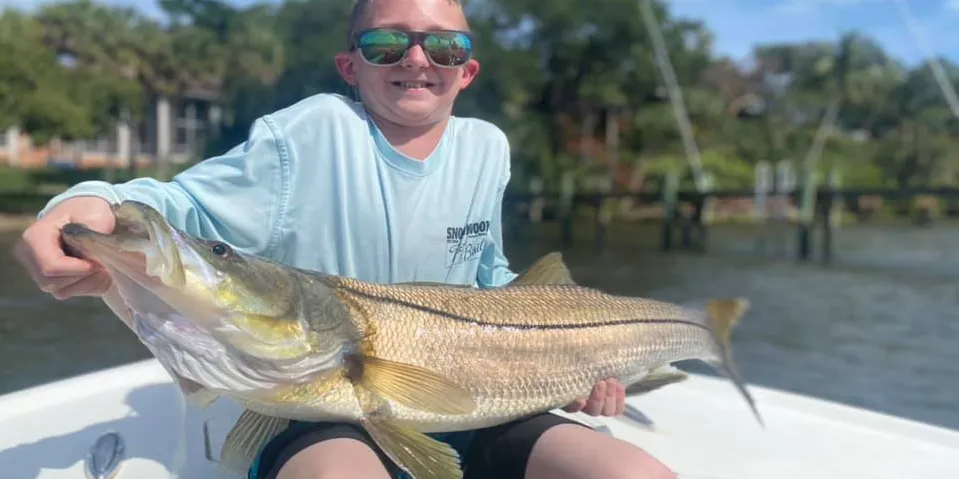Description
In Florida, there are five kinds of snook fish, each living in both brackish and freshwater. The common snook is the most widespread and well-known among them.
Unlike before when snook were rare in certain areas, they are now found all over Florida, and they’re adapting to colder waters. Snook fishing is a big deal, attracting anglers from around the world who are drawn to the excitement of catching these fish known for their strong runs and delicious taste. Among snook species, the common snook is celebrated as one of the best fighters in inshore fishing globally.
In winter, most snook move to freshwater canals or brackish rivers to handle the cold months, as they can’t endure temperatures below 60 degrees for too long. They prefer darker freshwater, which holds heat better than the clearer waters of the Gulf or the Atlantic Ocean.

APPEARANCE OF COMMON SNOOK
The common snook is easily identified by its long body, concave snout, protruding lower jaw, and sloping forehead. A distinctive feature is its black lateral line, consisting of 67-72 pored scales, extending into the caudal fin. Common snooks also have a split high dorsal fin and a yellow pelvic fin.
Range: You can find common snooks in South Florida, from Cape Canaveral on the east coast to near Tarpon Springs on the west coast. While not as numerous in northern Florida or the panhandle, they still exist there.
Habitat: Common snooks prefer inshore coastal waters, especially around mangrove shorelines, beaches, seagrass beds, and nearby structures. Freshwater snooks can thrive in any freshwater or lightly brackish waterway, even small residential canals throughout Florida.
All types of snook, including large ones, can be found in freshwater canals. Some even venture as far inland as Lake Okeechobee. Globally, snooks inhabit areas from South Carolina to Brazil, along the Gulf of Mexico from Florida to Texas. They can adapt to various habitats as long as the water quality is good and temperatures stay above 60 degrees Fahrenheit.

Age and Growth: Common snooks can grow impressively, reaching up to 48 inches or 50 pounds. They are the largest among Atlantic species, growing faster and bigger in Atlantic waters than in the Gulf of Mexico.
Behavior and Spawning: Freshwater snooks start as males, with some turning into females when they reach 18 to 22 inches. During the spawning season, they form schools and can be spotted near South Florida beaches in the summer. Large schools of snook gather annually in deep passes and inlets for spawning.
Feeding Habits: Freshwater snooks primarily feed on other fish and large crustaceans.
FRESHWATER SNOOK SPECIES
All types and sizes of snook can be found in the freshwater and brackish areas along Florida’s east and west coasts. The common snook is the largest and most well-known, while the sword spine snook is the smallest, particularly favoring freshwater or lightly brackish environments.
The sword spine snook stands out due to its anal fin that extends to its tail, a feature that distinguishes it from other snook species. Despite being petite, with the larger ones reaching 15 to 16 inches but most staying under 10 inches, they have comparatively larger scales.
If given the choice, sword spine snooks would prefer to live exclusively in freshwater. They have a strong preference for entirely freshwater or slightly brackish waters and avoid purely saltwater environments.
As the smallest among Florida’s snook species, sword spine snooks thrive in mangrove roots and brackish estuaries. These areas are fresh enough for their liking but too salty for largemouth bass to flourish.
SNOOK FISHING
Freshwater snook fishing in Florida is great year-round, especially in canals. However, the prime time for freshwater snook fishing is during the winter when these fish seek warmer waters.
In winter, common snooks often venture into Florida rivers or canals for warmth, exhibiting feeding behaviors similar to largemouth bass and snakehead. Their diet includes bluegill, crawfish, frogs, small mullet, snakes, ducks, and baby alligators.
For those seeking saltwater snook during winter, a deeper search may be necessary, exploring inlets, bridge pilings, or offshore wrecks.
Both saltwater and freshwater snook position themselves to face moving water, waiting to ambush prey carried by the current. Once hooked, these acrobatic fish jump above the water, akin to tarpon, and engage in vigorous and lengthy runs.
Landing a freshwater grand slam of largemouth bass, peacock bass, and snook in one trip is not uncommon among Florida anglers.
Fishing Tips: Live pinfish, mullet, or shrimp are top choices for catching snook. Free-lined sardines, fished off the bottom with a fish finder, are also effective. Adjusting tactics based on the season can enhance success.
Snook mainly feed on shrimp, bivalves, and mud crabs in summer, shifting to pinfish and shrimp in the fall, and focusing on mud crabs, snapping shrimps, and worm-like invertebrates in winter.
Contrary to belief, baitfish or shrimp doesn’t need to be large to catch a big snook. Even small baits, when cast in the right spot, can attract sizable snook.
Snook fishing offers the ultimate Florida experience, especially in shallow waters near grass flats, mangroves, oyster bars, or urban canals.
Edibility: Freshwater snook meat is white, moderately firm, and best enjoyed fresh. While not as delicate as trout, it’s not as dense as swordfish.
Records: The Florida state record is 44 pounds 3 ounces, caught in Ft. Myers. The fly-caught record is 30 pounds, 4 ounces.
The IGFA world record is 53 pounds 10 ounces, caught in Parismina Ranch, Costa Rica.
Conclusion:
Catching freshwater snook requires a combination of knowledge, skill, and patience. By understanding snook behavior, choosing the right tackle, and practicing effective techniques, you can increase your success rate and enjoy the excitement of landing these elusive fish from the shoreline.

















